Junkers Ju 52
| Ju 52 | |
|---|---|
 | |
| Ju-Air Junkers Ju-52/3m in flight over Austria (July 2013) | |
| Role | Transport aircraft, medium bomber, airliner |
| Manufacturer | Junkers |
| Designer | Ernst Zindel |
| First flight | 13 October 1930 (Ju 52/1m); 7 March 1932 (Ju 52/3m) |
| Status | Active |
| Primary users | Luftwaffe Luft Hansa Spanish Air Force |
| Produced | 1931–1945 (Germany) 1945–1947 (France) 1945–1952 (Spain) |
| Number built | 4,845 |
|
| |
The Junkers Ju 52/3m (nicknamed Tante Ju ("Aunt Ju") and Iron Annie) is a German trimotor transport aircraft manufactured from 1931 to 1952. Initially designed with a single engine but subsequently produced as a trimotor it saw both civilian and military service during the 1930s and 1940s. In a civilian role, it flew with over twelve air carriers including Swissair and Deutsche Luft Hansa as an airliner and freight hauler. In a military role, it flew with the Luftwaffe as a troop and cargo transport and briefly as a medium bomber. The Ju 52 continued in postwar service with military and civilian air fleets well into the 1980s.
Design and development
The Ju 52 was similar to the company's previous Junkers W 33, although larger. In 1930, Ernst Zindel and his team designed the Ju 52 at the Junkers works at Dessau. The aircraft's unusual corrugated duralumin metal skin, pioneered by Junkers during World War I, strengthened the whole structure.
The Ju 52 had a low cantilever wing, the midsection of which was built into the fuselage, forming its underside.[1] It was formed around four pairs of circular cross-section duralumin spars with a corrugated surface that provided torsional stiffening. A narrow control surface, with its outer section functioning as the aileron, and the inner section functioning as a flap, ran along the whole trailing edge of each wing panel, well separated from it. The inner flap section lowered the stalling speed and the arrangement became known as the Doppelflügel, or "double wing".[2]

The outer sections of this operated differentially as ailerons, projecting slightly beyond the wingtips with control horns. The strutted horizontal stabilizer carried horn-balanced elevators which again projected and showed a significant gap between them and the stabilizer, which was adjustable in-flight. All stabilizer surfaces were corrugated.
The fuselage was of rectangular section with a domed decking, all covered with corrugated light alloy. There was a port side passenger door just aft of the wings, with windows stretching forward to the pilots' cockpit. The main undercarriage was fixed and divided; some aircraft had wheel fairings, others not. There was a fixed tailskid, or a later tailwheel. Some aircraft were fitted with floats or skis instead of the main wheels.
In its original configuration, designated the Ju 52/1m, the Ju 52 was a single-engined aircraft, powered by either a BMW IV or Junkers liquid-cooled V-12 engine. However, the single-engine model was underpowered, and after seven prototypes had been completed, all subsequent Ju 52s were built with three radial engines as the Ju 52/3m (drei motoren — "three engines"). Originally powered by three Pratt & Whitney R-1690 Hornet radial engines, later production models mainly received 574 kW (770 hp) BMW 132 engines, a licence-built refinement of the Pratt & Whitney design. Export models were also built with 447 kW (600 hp) Pratt & Whitney R-1340 Wasp and 578 kW (775 hp) Bristol Pegasus VI engines. The two wing-mounted radial engines of the Ju 52/3m had half-chord cowlings and in planform view (from above/below) appeared to be splayed outwards, being mounted at an almost perpendicular angle to the tapered wing's sweptback leading edge (in a similar fashion to the Mitsubishi G3M bomber and Short Sunderland; the angled engines on the Ju 52 were intended to make it easier to maintain straight flight should an engine fail, while the others had different reasons). The three engines had either Townend ring or NACA cowlings to reduce drag from the engine cylinders, although a mixture of the two was most common (as can been seen in many of the accompanying photographs), with deeper-chord NACA ducts on the wing engines and a narrow Townend ring on the center engine (which was more difficult to fit a deeper NACA cowl onto, due to the widening fuselage behind the engine). Production Ju 52/3m aircraft flown by Luft Hansa before World War II, as well as Luftwaffe-flown Ju 52s flown during the war, usually used an air-start system to turn over their trio of radial engines, using a common compressed air supply that also operated the main wheels' brakes.
Operational history
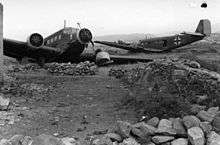
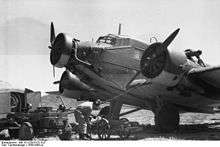



Prewar civil use
In 1932, James A. Richardson's Canadian Airways received (Werknummer 4006) CF-ARM, the sixth ever-built Ju 52/1m. The aircraft, first re-fitted with an Armstrong Siddeley Leopard radial engine and then later with a Rolls-Royce Buzzard and nicknamed the "Flying Boxcar" in Canada,[3][4] could lift approximately three tons and had a maximum weight of 7 tonnes (8 tons). It was used to supply mining and other operations in remote areas with equipment too big and heavy for other aircraft then in use. The Ju 52/1m was able to land on wheels, skis or floats (as were all Ju 52 variants).[5]
Before the nationalisation of the German aircraft industry in 1935, the Ju 52/3m was produced principally as a 17-seat airliner. It was used mainly by Luft Hansa and could fly from Berlin to Rome in eight hours. The Luft Hansa fleet eventually numbered 80 and flew from Germany on routes in Europe, Asia and South America.
Military use 1932–1945
The Colombian Air Force used three Ju 52/3mde bombers equipped as floatplanes during the Colombia-Peru War in 1932–1933. After the war, the air force acquired three other Ju 52mge as transports; the type remained in service until after World War II.
Bolivia acquired four Ju 52s in the course of the Chaco War (1932–1935), mainly for medical evacuation and air supply. During the conflict, the Ju 52s alone transported more than 4,400 tons of cargo to the front.[6]
In 1934, Junkers received orders to produce a bomber version of the Ju 52/3m to serve as interim equipment for the bomber units of the still-secret Luftwaffe until it could be replaced by the purpose designed Dornier Do 11.[7] Two bomb bays were fitted, capable of holding up to 1,500 kg (3,300 lb) of bombs, while defensive armament consisted of two 7.92mm MG 15 machine guns, one in an open dorsal position, and one in a retractable "dustbin" ventral position, which could be manually winched down from the fuselage to protect the aircraft from attacks from below. The bomber could be easily converted to serve in the transport role.[8] The Dornier Do 11 was a failure, however, and the Junkers ended up being acquired in much larger numbers than at first expected, with the type being the Luftwaffe's main bomber until more modern aircraft such as the Heinkel He 111, Junkers Ju 86 and Dornier Do 17 entered into service.[9][10]
The Ju 52 first saw military service in the Spanish Civil War against the Spanish Republic. It was one of the first aircraft delivered to the fraction of the army in revolt in July 1936 as both a bomber and transport. In the former role, it participated in the bombing of Guernica. No more of the bomber variant were built after this war, though it was again used as a bomber during the bombing of Warsaw[11] during the Invasion of Poland of September 1939. The Luftwaffe then relied on the Ju 52 for transport roles during World War II, including paratroop drops.
World War II
In service with Lufthansa, the Ju 52 had proved to be an extremely reliable passenger airplane. Therefore, it was adopted by the Luftwaffe as a standard aircraft model. In 1938, the 7th Air Division had five air transport groups with 250 Ju 52s. The Luftwaffe had 552 Ju 52s at the start of World War II. Even though it was built in great numbers, the Ju 52 was technically obsolete. Between 1939 and 1944, 2,804 Ju 52s were delivered to the Luftwaffe (1939: 145; 1940: 388; 1941: 502; 1942: 503; 1943: 887; and 1944: 379). The production of Ju 52s continued until approximately the summer of 1944; when the war came to an end, there were still 100 to 200 available.
The Ju 52 could carry eighteen fully equipped soldiers, or twelve stretchers when used as an air ambulance. Transported material was loaded and unloaded through side doors by means of a ramp. Air dropped supplies were jettisoned through two double chutes; supply containers were dropped by parachute through the bomb-bay doors, and paratroopers jumped through the side doors. SdKfz 2 kettenkraftrad (half-track motorcycles) and supply canisters for parachute troops were secured under the fuselage at the bomb bay exits and were dropped with four parachutes. A tow coupling was built into the tail-skid for use in towing freight gliders. The Ju 52 could tow up to two DFS 230 gliders.
Heavy losses in combat
The first major operation for the aircraft was in Operation Weserübung, the attack on Denmark and Norway on 9 April 1940. Fifty-two Ju 52s from 1. and 8. Staffel in Kampfgeschwader 1 transported a company of Fallschirmjäger and a battalion of infantry to the northern part of Jutland, and captured the airfield at Aalborg, vital to support the operation in southern Norway. Several hundred Ju 52s were used to transport troops to Norway in the first days of this campaign.
The Netherlands
Later, Ju 52's participated in the attack on the Netherlands on 10 May 1940, where they were deployed in the first large-scale air attack with paratroops in history during the Battle for The Hague. No fewer than 295 Ju 52s were lost in that venture and in other places in the country, due to varying circumstances, among which were accurate and effective Dutch anti-aircraft defences and German mistakes in using soggy airfields not able to support the heavy craft.[12] On 10 May alone, 278 were downed or disabled.
Thus, almost an entire year's production was lost in one day in the Netherlands. The lack of sufficient numbers of aircraft most probably heavily influenced the decision not to invade England following the Battle of Britain.[12]
After the Netherlands
After the campaign in the West, the air transport units were brought up to their pre-Netherlands strength and were assembled at airfields in the Lyon, Lille, and Arras areas in August 1940.[13] Probably this was done using new and repaired aircraft augmented by other transport planes like the FW-200 Condor and the Ju 90.
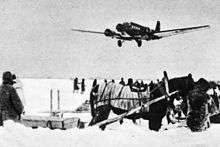
The next major use of the Ju 52 was in the Balkans campaign, most famously in the Battle of Crete in May 1941. Lightly armed, and with a top speed of only 265 km/h (165 mph) – half that of a contemporary Hurricane – the Ju 52 was very vulnerable to fighter attack and an escort was always necessary when flying in a combat zone. Many Ju 52's were shot down by anti-aircraft guns and fighters while transporting supplies, most notably during the desperate attempt to resupply the trapped German Sixth Army during the final stages of the Battle of Stalingrad in the winter of 1942–1943.
During the North African Campaign, the Ju 52 was the mainstay reinforcement and resupply transport for the Germans, starting with 20 to 50 flights a day to Tunisia from Sicily in November 1942, building to 150 landings a day in early April as the Axis situation became more desperate. The Allied air forces developed a counter-air operation over a two-month period and implemented Operation Flax on 5 April 1943, destroying 11 Ju 52s in the air near Cap Bon and many more during bombing attacks on its Sicilian airfields, leaving only 29 flyable.[14] That began two catastrophic weeks in which more than 140 were lost in air interceptions,[15] culminated on 18 April with the "Palm Sunday Massacre" in which 24 Ju 52s were shot down and another 35 staggered back to Sicily and crash-landed.[16]

The seaplane version, equipped with two large floats, served during the Norwegian Campaign in 1940, and later in the Mediterranean theatre. Some Ju 52's, both floatplanes and landplanes, were also used as minesweepers, known as Minensuch — literally, "mine-search" aircraft in German — fitted with a 14-metre (46 ft) diameter current-carrying degaussing ring under the airframe to create a magnetic field that triggered submerged naval mines and usually given an -"MS" suffix to designate them, as with the similarly equipped Bv 138 MS trimotor flying boat.[17]
Hitler's personal transport
Hitler used a Deutsche Lufthansa Ju 52 for campaigning in the 1932 German election, preferring flying to transport by train. After he became Chancellor of Germany in 1933, Hans Baur became his personal pilot, and Hitler was provided with a personal Ju 52. Named Immelmann II after the World War I ace Max Immelmann, it carried the registration D-2600.[18] As his power and importance grew, Hitler's personal air force grew to nearly 50 aircraft, based at Berlin Tempelhof Airport and made up of mainly Ju 52s, which also flew other members of his cabinet and war staff. In September 1939 at Baur's suggestion, Immelmann II was replaced by a four-engine Focke-Wulf Fw 200 Condor, although Immelman II remained his backup aircraft for the rest of World War II.
Chiang Kai-shek's personal transport

Eurasia was the main Chinese Airliner Company in the 1930s and the Ju-52 was their main airliner plane. One of them was commandeered by the Chinese Nationalist Party Government and became Chiang Kai-shek's personal transport.
Postwar use
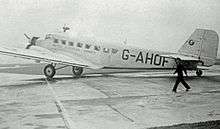
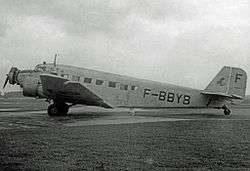
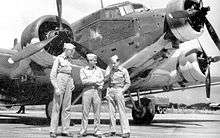
Various Junkers Ju 52s continued in military and civilian use following World War II. In 1956, the Portuguese Air Force, who was already using the Ju 52s as a transport plane, employed the type as a paratroop drop aircraft for its newly organized elite parachute forces, later known as the Batalhão de Caçadores Páraquedistas. The paratroopers used the Ju 52 in several combat operations in Angola and other Portuguese African colonies before gradually phasing it out of service in the 1960s.[19]
The Swiss Air Force also operated the Ju 52 from 1939 to 1982 when three aircraft remained in operation, probably the last and longest service in any air force.[20] Museums hoped to obtain the aircraft, but they were not for sale.[21] They are still in flying condition and together with a CASA 352 can be booked for sightseeing tours with Ju-Air.[22] During the 1950s the Ju 52 was also used by the French Air Force during the First Indochina War as a bomber. The usage of these Junkers was quite limited.[23]
The Spanish Air Force operated the Ju 52, nicknamed Pava, until well into the 1970s. Escuadrón 721 flying the Spanish-built versions, was employed in training parachutists from Alcantarilla Air Base near Murcia.[24]
Some military Ju 52s were converted to civilian use. For example, British European Airways operated eleven ex-Luftwaffe Ju 52/3mg8e machines, taken over by the RAF, between 1946 and retirement in 1947 on intra-U.K. routes before the Douglas DC-3 was introduced to the airline.[2] French airlines such as Societe de Transports Aeriens (STA) and Air France flew Toucans in the late 1940s and early 1950s.
A Ju 52 and a Douglas DC-3 were the last aircraft to take off from Berlin Tempelhof Airport before all operations ceased there on October 30, 2008.[25]
Other versions
Most Ju 52s were destroyed after the war, but 585 were manufactured after 1945. In France, the machine had been manufactured during the war by the Junkers-controlled Avions Amiot company, and production continued afterwards as the Amiot AAC 1 Toucan. In Spain, Construcciones Aeronáuticas SA continued production as the CASA 352 and 352L. Four CASA 352s are airworthy and in regular use today.
A CASA-built Ju52/3m appears in the opening sequence of the 1968 Richard Burton and Clint Eastwood film Where Eagles Dare.
Variants
Data from Junkers Aircraft & Engines 1913–1945[26]
- Ju 52
- Prototype of the single-engined transport aircraft, of twelve laid down only six were completed as single-engined aircraft. First flight: 3 September 1930, powered by a BMW VIIaU engine.[27]
- Ju 52/1mba
- The prototype Ju 52, (c/n 4001, regn D-1974), re-designated after being re-engined with a single Junkers L88 engine.
- Ju 52/1mbe
- Aircraft powered by BMW VIIaU
- Ju 52/1mca
- D-1974 fitted with drag flaps and re-fitted with a BMW VIIaU
- Ju 52/1mcai
- D-2356, (c/n 4005), crashed in May 1933.
- Ju 52/1mce
- D-USON (c/n 4003) used as a target tug. D-2317, (c/n 4004), converted to a torpedo bomber in Sweden as the K 45
- Ju 52/1mdo
- D-1974 fitted with a Junkers Jumo 4 engine as a testbed, re-registered as D-UZYP from 1937.
- Ju 52/1mbi
- The second prototype, (c/n 4002, regn D-2133), fitted with an 600 kW (800 hp) Armstrong Siddeley Leopard engine.
- Ju 52/1mci
- The second prototype fitted with 11.05 m (36 ft 3 in) long stepped floats, flying from the River Elbe on 17 July 1931
- Ju 52/1mdi
- The second prototype after having the floats removed and undercarriage reinstated, registered as D-USUS from 1934.
- Ju 52/3m
- Three-engine prototype, powered by three 410 kW (550 hp) Pratt & Whitney R-1340 Wasp engines. First flight: 7 March 1932
- Ju 52/3mce
- Three-engine civil transport aircraft.
- Ju 52/3mge
- Interim bomber and transport aircraft for the Luftwaffe.
- Ju 52/3mg3e
- Improved military version, powered by three 541 kW (725 hp) BMW 132-A3 (improved version of the Pratt & Whitney R-1690 Hornet) radial engines, equipped with an improved radio and bomb-release mechanism.
- Ju 52/3mg4e
- Military version. The tailskid was replaced by a tailwheel.
- Ju 52/3mg5e
- Military version, powered by three 619 kW (830 hp) BMW 132T radials. It could be fitted with interchangeable floats, skis and wheel landing gear.
- Ju 52/3mg6e
- Equipped with a simplified radio.
- Ju 52/3mg7e
- Fitted with an autopilot and a large loading hatch.
- Ju 52/3mg8e
- Fitted with an extra cabin-roof hatch.
- Ju 52/3mg9e
- Late production version, fitted with strengthened landing gear and glider towing gear.
- Ju 52/3mg10e
- Similar to the Ju 52/3mg9e, but it could be fitted with floats or wheels.
- Ju 52/3mg11e
- No details are known.
- Ju 52/3mg12e
- Powered by three BMW 132L radials.
- Ju 52/3m12e
- Some Ju 52/3mg12s were sent to Luft Hansa.
- Ju 52/3mg13e
- No details are known.
- Ju 52/3mg14e
- this was the last German production version.

- A.A.C. 1 Toucan
- Post-war French version, 415 built.[28]
- CASA 352
- Post-war Spanish version, 106 built.[28]
- CASA 352L
- Spanish version with Spanish 578 kW (775 hp) ENMA Beta B-4 (license-built BMW 132) engines, 64 built.[28][29]
- C-79
- Designation assigned to a single example operated by the United States Army Air Forces.[30]
- T2B
- Designation used by the Spanish Air Force.
- Tp 5
- Designation used by the Swedish Air Force.
- K 45c
- A single Ju 52/1mce (c/n 4004) was delivered to the Junkers factory at Limhamn in Sweden, where it was converted to a torpedo bomber as the K 45c.
Operators

Accidents and incidents
Surviving aircraft
Airworthy aircraft
As of 2008, eight Ju 52 remain in operation, four of which operate pleasure flights from Dübendorf airport in Switzerland.[31] Lufthansa operates one Ju 52/3m (D-AQUI) for air shows and pleasure flights.[32]
Aircraft on display
- Germany
- Junkers Ju 52/3m (Amiot AAC.1 Toucan) is on display at the Deutsches Technikmuseum in Munich. Ex FAF 363
- Junkers Ju 52/3m (CASA 352L, c/n 016) is on display at the Flugausstellung Leo Junior at Hermeskeil, Germany.[33]
- Junkers Ju 52/3m (D-AZAW) is on display at the Deutsches Technikmuseum in Berlin[34]
- Junkers Ju 52/3m is on display at the Technikmuseum "Hugo Junkers" in Dessau, which is situated where the Junkers factory stood up until 1945.[35]
- Junkers Ju 52/3m g4e (WNr.6693) is on display at "Ju 52 Hangar" of Traditionsgemeinschaft Lufttransport Wunstorf e. V.(Air Transport Community of Tradition) near Wunstorf/Germany.[36]
- Junkers Ju 52/3m (D-ANOY) is on display at the Visitors Park at Munich Airport.[37]
- Argentina
- Junkers Ju 52/3m (WNr.4043) is on display at the Museo Nacional de Aeronáutica de Argentina (National Aeronautics Museum) in Morón, Buenos Aires.[38]
- Belgium
- Junkers Ju 52/3m is on display at the Royal Museum of the Armed Forces and Military History in Brussels.
- Colombia
- Junkers Ju 52/3m ge (AMC-625) is display at the MAECO Museum of Colombian Air Force in El Dorado Airport, Bogotá, Colombia.
- France
- An Amiot AAC.1 Toucan was acquired in 2011 by the Association des Mécanicians-Pilotes d'Aéronefs Anciens, Brétigny-sur-Orge, Essonne, France. Formerly with the Portuguese Air Force as 6311, it had been stored for over 40 years at the Portuguese Air Force Museum, Alverca do Ribatejo.[39]
- Norway
- Junkers Ju 52/3m (CASA 352L)(LN-DNL) is on display at the Norwegian Aviation Museum, Bodø, Norway.[40]
- Junkers Ju 52/3m g4e (CA+JY) is on display at the Norwegian Armed Forces Aircraft Collection at Gardermoen near Oslo, Norway.[41]
- Poland
- Junkers Ju 52/3m g10e (Amiot AAC.1 Toucan) previously exhibited in Duxford is on display at the Polish Aviation Museum in Kraków.
- Portugal
- Junkers Ju 52/3m ge is on display at the Museu do Ar in Sintra, Portugal.
- Serbia
- Junkers Ju 52/3m (Amiot AAC.1 Toucan) 7208 ex F-BBYB is on display at the Museum of Aviation, Belgrade
- Spain
- Junkers Ju 52/3m (CASA 352) is on display at the Spanish Air Museum in Cuatro Vientos (Madrid, Spain).
- United Kingdom
- Junkers Ju 52/3m (CASA 352L) is on display at the Royal Air Force Museum in Cosford.[42]
- United States
- Junkers Ju 52/3m (CASA 352L) is on display at the Steven F. Udvar-Hazy Center of the National Air and Space Museum in Chantilly, Virginia.[43]
- Junkers Ju 52/3m (CASA 352L) is at the National Museum of the United States Air Force in Dayton, Ohio. The aircraft was donated to the museum by the Spanish government in 1971. After being on display outside for 40 years the aircraft has been placed in indefinite storage to protect it from further deterioration.[44]
- Junkers Ju 52/3m (CASA 352L) (N352JU) is on display at the Military Aviation Museum, Virginia Beach, Virginia.
Specifications (Junkers Ju 52/1m ce)
Data from Wolfgang Wagner[45]
General characteristics
- Crew: two
- Capacity: 1,820 kg (4,000 lb) of freight
- Length: 18.50 m (60 ft 8 in)
- Wingspan: 29.50 m (96 ft 9 in)
- Height: 4.65 m (15 ft 3 in)
- Wing area: 116 m² ()
- Empty weight: 4,000 kg (8,830 lb)
- Max. takeoff weight: 7,000 kg (15,450 lb)
- Powerplant: 1 × BMW VIIaU V-12 piston engine, 507 kW (680 hp)690 PS[46]
Performance
- Maximum speed: 195 km/h (121 mph) at sea level
- Cruise speed: 160 km/h (100 mph)
- Range: 1,000 km (620 mi)
- Service ceiling: 3,400 m (11,150 ft)
- Rate of climb: 2.30 m/s at sea level (450 ft/min) 8.6 min to 1,000 m (3,300 ft); 20.5 min to 2,000 m (6,600 ft)
- Wing loading: 60.34 kg/m² ()
- Power/mass: 13.8 kg/kW (10.14 kg/PS)
Specifications (Junkers Ju 52/3m ce)
Data from Wolfgang Wagner "Hugo Junkers Pionier der Luftfahrt - Seine Flugzeuge" Bernard & Graefe Verlag, Bonn 1996 ISBN 3-7637-6112-8 (in German) p. 358
General characteristics
- Crew: two
- Capacity: 17 passengers
- Length: 18.90 m ()
- Wingspan: 29.25 m ()
- Height: 6.10 m ()
- Wing area: 110.5 m² ()
- Empty weight: 5,970 kg (13,180 lb)
- Max. takeoff weight: 9,210 kg (20,330 lb)
- Powerplant: 3 × BMW Hornet A2, 386 kW (525 PS) each
Performance
- Maximum speed: 271 km/h (168 mph) at 900 m
- Cruise speed: 222 km/h (138 mph)
- Range: 950 km (590 mi)
- Service ceiling: 5,200 m (17,050 ft)
- Rate of climb: 3.90 m/s ()
- Wing loading: 83.35 kg/m² ()
- Power/mass: 7.95 kg/kW (5.85 kg/PS)
Specifications (Junkers Ju 52/3m g7e)

Data from Jane’s Fighting Aircraft of World War II[47]
General characteristics
- Crew: three (two pilots, radio operator)
- Capacity: 18 troops or 12 litter patients
- Length: 18.90 m (62 ft 0 in)
- Wingspan: 29.25 m (95 ft 10 in)
- Height: 4.5 m (14 ft 10 in)
- Wing area: 110.5 m² (1,190 ft²)
- Empty weight: 6,510 kg (14,325 lb)
- Loaded weight: 9,200 kg (20,270 lb)
- Max. takeoff weight: 10,990 kg (24,200 lb)
- Powerplant: 3 × BMW 132T radial engines, 533 kW (715 hp)[48] each
Performance
- Maximum speed: 265 km/h (165 mph) at sea level
- Cruise speed: 211 km/h (132 mph)
- Range: 870 km (540 mi)
- Service ceiling: 5,490 m (18,000 ft)
- Rate of climb: 2.99 m/s; 17 minutes to 3,050 m (10,000 ft)
Armament
- Guns:
- 1 × 13 mm (.51 in) MG 131 machine gun in a dorsal position
- 2 × 7.92 mm (.312 in) MG 15 machine guns
- Bombs: up to 500 kilograms (1,100 lb) of bombs (some variants)
See also
- Related development
- Aircraft of comparable role, configuration and era
- Related lists
References
Notes
- ↑ Grey and Bridgman 1972
- 1 2 Jackson 1960, p. 100.
- ↑ "'Bud' Johnston Library." Rolls-Royce of Canada Ltd., Montreal Quebec.
- ↑ "Flying Box Car for Sky Lanes Of Northland." Popular Mechanics, May 1939.
- ↑ "Junkers_Ju-52/1m ." scramble.nl. Retrieved: 12 October 2010.
- ↑ Hagedorn, Dan & Antonio Luis Sapienza (1996) Aircraft of the Chaco War, 1928–1935. Schiffer Publishing Co. Atglen, pp. 96–100. ISBN 0764301462
- ↑ Green 1972, p. 405.
- ↑ Green 1972, p. 406.
- ↑ Green 1972, pp. 405–406.
- ↑ Smith and Kay 1972, p. 360.
- ↑ "Warsaw." richmond.edu. Retrieved: 12 October 2010.
- 1 2 Dr L. de Jong, 'Het Koninkrijk der Nederlanden in de Tweede Wereldoorlog'(Dutch)
- ↑ Page 50, "German Air Force Air Lift Operations", by GeneralMajor Fritz Morzik, USAF Historical Division, 1961
- ↑ Craven and Cate 1949, pp. 189–190
- ↑ Craven and Cate 1949, pp. 190–191
- ↑ Weal 2003, p. 91.
- ↑ The Aeroplane Monthly, June 1994 p. 28.
- ↑ Hoffmann 2000, p. 75.
- ↑ Afonso and Gomes 2000, pp. 178–183.
- ↑ airforce history "Ju-52."Swiss Air Force History. Retrieved: 12 October 2010.
- ↑ McPhee, John (1983-11-07). "La Place de la Concorde Suisse-II". The New Yorker. p. 55. Retrieved 22 July 2013.
- ↑ "Ju 52." Museum of Military Aviation. Retrieved: 12 October 2010.
- ↑ Duwelz, Yves. "Junkers Ju 52/3mge W Nr 5670 6309." Aviation Heritage in Belgium, October 2001. Retrieved: 4 April 2009.
- ↑ "Escuela Militar de Paracaidismo" (Military school of Parachuting) (in Spanish). ejercitodelaire.mde.es. Retrieved: 4 November 2010.
- ↑ Kulish, Nicholas. "Crowds Bid Fond Farewell to Airport That Saved Berlin." The New York Times, 30 October 2008. Retrieved: 4 April 2009.
- ↑ Kay, Anthony L. (2004). Junkers Aircraft & Engines 1913–1945. London: Putnam Aeronautical Books. ISBN 0 85177 985 9.
- ↑ "Aerial Furniture Van Has Capacity of Three Tons" Popular Mechanics, July 1931
- 1 2 3 Blewett 2007
- ↑ http://www.flightglobal.com/FlightPDFArchive/1968/1968%20-%201509.PDF FLIGHT International, 8 August 1968
- ↑ Hagedorn, Dan (Fall 1992). "The Trek of the Aconcagua". AAHS Journal. Huntington Beach, CA: American Aviation Historical Society. 37 (3): 227.
- ↑ "Aviation Museum Dóbendorf". Retrieved 25 June 2014.
- ↑ "Queen of the Skies". Deutsche Lufthansa Berlin-Stiftung. Retrieved 25 June 2014.
- ↑ http://www.flugausstellung.de/flugzeuge.html. Retrieved: 24 May 2011.
- ↑ "Ju 52/3m." Deutsches Technikmuseum. Retrieved: 12 October 2010.
- ↑ Technikmuseum Hugo Junkers Dessau. Retrieved: 22 June 2011.
- ↑ "Junkers Ju-52/3m g4e." Traditionsgemeinschaft Lufttransport Wunstorf . Retrieved: 12 October 2010.
- ↑ "Junkers Ju 52/3m [1937]". Munich Airport. Retrieved 15 May 2015.
- ↑ Brea, Esteban (13 March 2012). "Museo Nacional de Aeronáutica: Más de medio siglo de preservación" [National Aeronautics Museum: More than half a century of preservation]. Gaceta Aeronautica (in Spanish). Retrieved 29 August 2015.
- ↑ "Junkers added to AMPAA collection". Aeroplane (August 2011): 12.
- ↑ "Ju 52." luftfahrt.museum.no. Retrieved: 12 October 2010.
- ↑ "List of aircraft displayed at the Norwegian Armed Forces Aircraft Collection."akersmus.no. Retrieved: 12 October 2010.
- ↑ "Junkers Ju52/3M (CASA 352L)." RAF Museum Cosford. Retrieved: 12 October 2010.
- ↑ "Junkers Ju52."Smithsonian National Air and Space Museum. Retrieved: 29 March 2015.
- ↑ "Junkers Ju 52."National Museum of the US Air Force. Retrieved: 29 August 2015.
- ↑ Wolfgang Wagner Hugo Junkers Pionier der Luftfahrt - Seine Flugzeuge Bernard & Graefe Verlag, Bonn 1996 ISBN 3-7637-6112-8 (in German) p. 342
- ↑ Originally measured as 690 PS
- ↑ Jane 1946, pp. 170–171.
- ↑ Originally measured as 725 PS
Bibliography
- Afonso, Aniceto and Carlos de Matos Gomes. Guerra Colonial (in Portuguese). Lisbon: Editorial Notícias, 2000. ISBN 972-46-1192-2.
- Blewett, R. Survivors (Aviation Classics). Coulsdon, UK: Gatwick Aviation Society, 2007. ISBN 978-0-9530413-4-3
- Craven, Wesley Frank, and Cate, James Lea, editors (1949). The Army Air Forces In World War II, Volume Two - Europe: Torch to Pointblank: August 1942-December 1943 Air Force Historical Studies Office, ISBN 0-912799-03-X.
- Green, William. Warplanes of the Third Reich. New York: Doubleday, 1972. ISBN 0-385-05782-2.
- Grey, Charles Gibson and Leonard Bridgman. Jane's All the World's Aircraft 1938. London: Newton Abott, David & Charles, 1972. ISBN 0-7153-5734-4.
- Hoffmann, Peter. Hitler's Personal Security: Protecting The Fuhrer 1921-1945. New York: Da Capo Press, 2000. ISBN 978-0-30680-947-7.
- Jackson, A.J.British Civil Aircraft 1919-59, Vol. 2. London: Putnam, 1960.
- Jane, Fred T. "The Junkers Ju 52/3m." Jane’s Fighting Aircraft of World War II. London: Studio, 1946. ISBN 1-85170-493-0.
- Morzik, GeneralMajor Fritz "German Air Force Air Lift Operations", USAF Historical Division, 1961
- Smith, J. R. and Antony L. Kay. German Aircraft of the Second World War. London: Putnam, 1972. ISBN 0-85177-836-4.
- Weal, John. Jagdgeschwader 27 'Afrika'. Oxford, UK: Osprey, 2003. ISBN 1-84176-538-4.
Further reading
- Cicalesi, Juan Carlos; Rivas, Santiago (2009). Núñez Padin, Jorge Felix, ed. Junkers F13 / W34 / K43 / Ju52. Serie en Argentina (in Spanish). 3. Bahía Blanca, Argentina: Fuerzas Aeronavales. ISBN 978-987-20557-7-6. Retrieved 2015-08-24.
External links
| Wikimedia Commons has media related to Junkers Ju 52. |